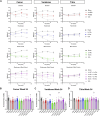The effect of black cohosh extract and risedronate coadministration on bone health in an ovariectomized rat model
- PMID: 38689663
- PMCID: PMC11058223
- DOI: 10.3389/fphar.2024.1365151
The effect of black cohosh extract and risedronate coadministration on bone health in an ovariectomized rat model
Abstract
Preparations of black cohosh extract are sold as dietary supplements marketed to relieve the vasomotor symptoms of menopause, and some studies suggest it may protect against postmenopausal bone loss. Postmenopausal women are also frequently prescribed bisphosphonates, such as risedronate, to prevent osteoporotic bone loss. However, the pharmacodynamic interactions between these compounds when taken together is not known. To investigate possible interactions, 6-month-old, female Sprague-Dawley rats underwent bilateral ovariectomy or sham surgery and were treated for 24 weeks with either vehicle, ethinyl estradiol, risedronate, black cohosh extract or coadministration of risedronate and black cohosh extract, at low or high doses. Bone mineral density (BMD) of the femur, tibia, and lumbar vertebrae was then measured by dual-energy X-ray absorptiometry (DEXA) at weeks 0, 8, 16, and 24. A high dose of risedronate significantly increased BMD of the femur and vertebrae, while black cohosh extract had no significant effect on BMD individually and minimal effects upon coadministration with risedronate. Under these experimental conditions, black cohosh extract alone had no effect on BMD, nor did it negatively impact the BMD-enhancing properties of risedronate.
Keywords: bisphosphonates; black cohosh; bone mineral density; dietary supplements; postmenopausal osteoporosis; risedronate.
Copyright © 2024 Inselman, Masters, Moore, Agarwal, Gassman, Kuijpers, Beger, Delclos, Swift, Camacho, Vanlandingham, Sloper, Nakamura, Gamboa da Costa, Woodling, Bryant, Trbojevich, Wu, McLellen and Christner.
Conflict of interest statement
The authors declare that the research was conducted in the absence of any commercial or financial relationships that could be construed as a potential conflict of interest.
Figures



References
-
- Bai W., Henneicke-von Zepelin H. H., Wang S., Zheng S., Liu J., Zhang Z., et al. (2007). Efficacy and tolerability of a medicinal product containing an isopropanolic black cohosh extract in Chinese women with menopausal symptoms: a randomized, double blind, parallel-controlled study versus tibolone. Maturitas 58 (1), 31–41. 10.1016/j.maturitas.2007.04.009 - DOI - PubMed
-
- Betz J. M., Anderson L., Avigan M. I., Barnes J., Farnsworth N. R., Gerdén B., et al. (2009). Black cohosh: considerations of safety and benefit. Nutr. Today 44 (4), 155–162. 10.1097/nt.0b013e3181af63f9 - DOI
-
- Cheng Z., Yao W., Zimmermann E. A., Busse C., Ritchie R. O., Lane N. E. (2009). Prolonged treatments with antiresorptive agents and PTH have different effects on bone strength and the degree of mineralization in old estrogen‐deficient osteoporotic rats. J. Bone Min. Res. 24 (2), 209–220. 10.1359/jbmr.81005 - DOI - PMC - PubMed
LinkOut - more resources
Full Text Sources

